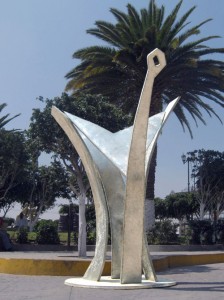
'ElVuelo del Corazon'. 2009 stainless steel 299 x195 x 130cm. Collection: Museo/Taller Miguel Hernandez Urban, Tultepec, Mexico.
This week HKAT is very proud to publish an interview by the internationally renowned and acclaimed sculptor Michael Lyons.
Lyons is one of the UK’s leading and most successful artists with a history and biography pages long, listing some of the most incredible accolades, exhibitions, positions and achievements that most can only dream of – achievements that are testament to Lyons’ passion, hard work and dedication to The Arts.
The sculpture Lyons creates is as comfortable on large scale (usually for a public piece) as it is on small scale. He uses mostly metals- fabricated steel, various casting techniques and in some pieces he combines materials and techniques. Although considered a sculptor, Lyons is a true Fine Artist. Lyons’ Drawing and Photography is integral to the sculpture he creates; in recent times he’s started to use Printmaking to further formulate his ideas and intentions.
Lyons takes his inspiration largely from travel. He spends much of his time in China, Mexico and Argentina; his works manifestations of these experiences. Landscape, poetry, forces of nature, mythology, culture and celestial bodies are some of the many elements that resonate through his work.
What are you working on at the moment?
Some years ago I began a project based on the stars and constellations, and the mythology surrounding them. There are over thirty pieces of different sizes and in a range of materials – often combined in a single sculpture e.g. wood, stone, bronze, steel, cast iron and so on.
They are not ‘illustrations’ but sculptural works which go through many changes before gradually beginning to represent a certain idea or theme.
I am also working on three separate exhibitions at three different venues to celebrate my 70th Birthday next year. One is retrospective, one is on the theme of landscape, and the other of completely new work entitled the ‘Mithras Suite’. The latter is a series of completely new freely made works, at present mostly in steel.
The Mithras religion was especially followed in Rome, and especially by the army. York, where I live is a Roman City – and symbols of Mithras can be found in the Museum, but also below the present city e.g. the war memorial is built over what was a Mithraic Temple.
In 2013 a book ‘The Sculpture of Michael Lyons’ is to be published to coincide with my Birthday. This is very time consuming – I am not the author of course, but it entails a great deal of collaboration and amassing of visual and written material.
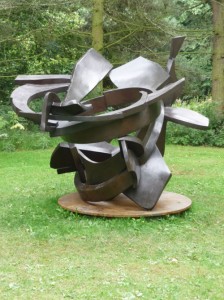
'Unity of Opposites: Vortex'. 2001 copper 185 x 119 x 235cm. Artist's Collection: on exhibition at the Fitzwilliam Museum Sculpture Promenade 2010/11, Cambridge University, UK. Currently on loan to Yorkshire Sculpture Park.
Why did you choose to specialize in Sculpture as opposed to painting or printmaking?
Well, I did no art at senior school from 11-16, but I had a feeling from years before that it was something I wanted to pursue, and applied to art school.
Strangely enough, the first class I walked into was the ‘modeling class’ –it scared the hell out of me because I’d never done anything like it before. Gradually, I started to make ‘sculptural things’ often to a theme e.g. ‘Figures in the Wind’.
I also liked painting, and some people encouraged me to go into the Painting School – but where I was at college at the time, the Sculpture School felt much freer and I wanted that freedom to develop.
I didn’t really do printmaking at art school; when I first started I did lithography as what they called a ‘craft’ – but I did not feel very happy doing it, it all seemed a bit of a mystery, especially as during the process the image completely disappeared for a time!!
Since then I have become much more interested in printmaking and am, at present, planning a series of etchings. I draw a lot and in recent years I have used colour in drawings, some of which people refer to as paintings.
I have always enjoyed the physicality of sculpture and its presence; I like the personal involvement with the ‘making’ process. It’s very important to understand this – even if someone else is actually doing the physical labour.
You regularly travel to China, Mexico and Argentina, how do you use these travels and experiences in your own work?
Well, when I travel I use a combination of journals, photography, and drawing to gain information, which I later use in sculpture, drawings or even poetry.
I first went to China in 1993, on the invitation of an ex –student from Manchester Metropolitan University named Li Xiu Qin. Li (as we always called her) was a teacher, and now a professor, at China National Academy. I taught steel sculpture, the first time this had been introduced into the curriculum of a Chinese Academy.
China was a complete shock to me, it completely disorientated me – I realized there was a whole world about which I was completely ignorant; it made me question who I was and the nature of my sculpture.
In 2000 I took part in the West Lake International Sculpture Symposium and Exhibition in Hangzhou, South China. This was the same city in which I had taught at the National Academy (then Zhejiang Academy).
During my first visit, I took a photograph of the beautiful lake in Hangzhou, with the sun blazing down on it and making the water look like molten steel. The lake has small boats on it, and is also famous for its lotuses. I imagined that I was in the cool ‘womb’ of the lake, with the surface of the lake with the lotuses, boats and surrounding mountains above me. I wrote a poem about this – and when the opportunity to make a huge work in Hangzhou arose, I translated the photographs and poem into a three dimensional model and it was enlarged by wonderful Chinese craftsmen into something that you could walk into and experience from many angles. It relates specifically to the city and the place – it is architectural, narrative and poetic; I could only have done this work because I had these experiences in China. The sculpture was called ‘The Lake Afire’
I have used aspects of Chinese landscape to inspire work and I have also read widely about the history, politics and philosophy of China. I have seen China change from the time I first went there in 1993 – this dynamic change is the backdrop against which I have been working. I lived for a period in Beijing, which I loved; its dynamism is something to which I have responded with works like ‘Unity of Opposites: Vortex’, the circular forms of which seems to trying to find balance and equilibrium within the maelstrom of urban activity.
In China I met a Peruvian sculptor, who introduced me to a Sculpture Symposium in Tultepec, Mexico – about 45 minutes from Mexico City, but a different world. Tultepec is famous for fireworks, and for the papier mache bulls, ‘Los Toros,’ which are carried around the town square near to the Feast of San Juan de Dios. The ‘toros’ festooned with fireworks chase the spectators through the darkness – symbols of the battle between good and evil. It is very primitive and very dangerous!!!
At the Symposia in Tultepec I have met many Latin American sculptors and worked in stainless steel. The works have been shown in many Mexican cities.
The works I consider to be most successful in Mexico are ‘Fleeting sun: Serpents Rising’ and ‘ El Vuelo del Corazon’ (The Flight of the Heart). The former relates to the desert, the landscape, the sun and snakes (I have always been a great admirer of D.H.Lawrence who lived for a time in Mexico, and whose poems for me, empathize with a sense of life and living things). This sculpture was not ‘designed’ with Mexico in mind, but became ‘Mexican’ through my involvement with the place, the workers and the atmosphere.
‘El Vuelo de Corazon’ was made to express freedom and celebrate the Mexican Revolution. The ‘heart’ is a potent symbol in Mexico – it is the ‘Sacred Heart of Jesus’ and the heart torn out in Aztec human sacrifice; ‘The Flight of the Heart’ refers to unfettered emotions and freedom of expression. The sculpture is formally strong, but possesses vulnerability in keeping with the title and meaning of the work.
I was invited to the Chaco Biennale, in Resistencia, Argentina. Resistencia is a city given over to sculpture. At the final event of the Biennale there were thousands and thousands of spectators watching the artists being awarded prizes.
The Biennale had a theme ‘Music’, and I brought a model with me, so I cannot claim to have responded at that time to place in terms of sculpture, though I was overwhelmed by the reception and the fact that sculpture was so much part of the city.
However, Argentina has a special place in my affections – some of my family emigrated to Argentina; my great aunt married an engineer, who went over to help to organize the Argentinean railway system, so a branch of my family lived in Buenos Aires and Argentina for many years. I loved Buenos Aires – its sophistication and its culture.
Below the surface, however, is the memory of the ‘State Terrorism’ of the time of the Generals. People remember this terrible time and I wanted to pay tribute to those who died. The words ‘The Angels of Buenos Aires’ kept going through my head like a song one can’t forget. When I was seriously ill in hospital in 2010, as I was recovering I began to give a visual identity to these vague but potent ideas. The suffering of those who died under the generals became identified with my own illness and struggle for survival. I have not as yet made sculptures from the drawings and poems produced at this time, but the situation in which I found myself freed up my imagery and I made images that I should normally not have had the courage to tackle.
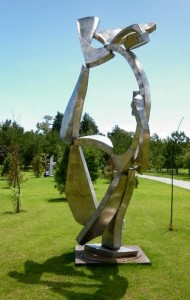
'Fleeting Sun': Serpents Rising'. 2007 stainless steel 420cm high. Collection: Museo/Taller Miguel Hernandez Urban, Tultepec Mexico. Exhibition of 'International Monumental Sculpture in Stainless Steel', Paseo de la Reforma, Mexico City 2007.
How do you select what to use and what to disregard from your experiences?
It doesn’t quite work like that – ideas and images can percolate away for a long time. Things often come to the surface or you find they are ‘cooked’ in the sense that you can see how to use them, whereas before they were just vague notions and feelings. In sculpture, I like things I can get my head around and develop, things that I can interpret in three dimensions e.g. I made, and am still making, a series called the ‘Dragon Light Series’. These come from a Chinese myth of dragons lying in their pools in winter – then at the onset of spring, they soar into the air and fight; their thunderous conflict bringing the rains and ensuring the fertility of the land. This really gripped my imagination, and I could see how I could abstractly express this in three-dimensional form – it had tremendous mileage for the development of dynamic form and poetic content.
I am only just beginning to see a way of dealing with ‘toros’ in Mexico, and not directly, but by way of another project – but some experiences simply enrich one’s view of the world. They extend one as a person but have no exact parallel in sculptural terms. Though they may lead to poetry, or exist in documentary form.
For example, some years ago I went to a town called San Juan Chimula, famous for a church in which Catholicism and the ancient religions of Mexico are intertwined. When we alighted from the ‘collectivo’ (small bus) a full scale political riot was in full swing – and the town square was full of hundreds of men in ponchos. The excitement spilled over into violence. Escaping from the crowd we entered the church – I have truly never seen anything like it. There were no seats or places to kneel, and a huge congregation of mostly Indians seemed to be in a kind of trance. I watched as a woman holding a cockerel cleansed and blessed her companion with the unfortunate bird and then broke its neck as a sacrifice to what god or gods I was unsure. I have never forgotten this incredible scene, the chanting, (the very potent smell!) and the sacrifice of the cockerel or the riot outside!!
However, I can’t do anything with this powerful memory in terms of sculpture – sculptural ideas usually come from, perhaps, more mundane beginnings.
What are the foundation key skills that you think someone needs to create art?
There is an exhibition in Manchester Art gallery of big works done in paper – suggesting that in the present economic climate artists are turning their backs on expensive materials and processes.
In fact all you need to make ‘Art’ are rudimentary materials – pencil, paper, scissors and your hands (and brain). Complex machinery won’t make the ‘art’ any better.
However, while I believe that good sculpture can be made with scrap wood and a glue gun, if you want to be a ‘professional’ sculptor you need to have some knowledge of working in clay, wood, stone, steel etc. It is a terrible thing I think that so many art schools have lost the skills that were always available and workshops and foundries have disappeared, as has happened in the Art School where I taught for many years (Manchester).
Likewise, in printmaking you need basic skills – advanced skills (if necessary) come with the growth of ideas.
Drawing is a common denominator in sculpture, painting and printmaking.
In terms of ‘skills’, which are not material based, you need determination, perseverance and belief in yourself – and a willingness to explore and not be afraid to go beyond one’s known capacity and experience.
What role does the artist have in today’s society, especially in today’s climate?
To be honest I don’t think I go around thinking about my social role – though I think art is of the utmost importance to society; just think of a society where artists, poets, musicians are not allowed to flourish, how linear and how boring everything would become with out the vision of artists.
Actually ‘The Artist’ is an archetype – within that there are many different sorts of artists – political artists, figurative artists, video artists – the list goes on and on. They may well all see themselves as being slightly different, and indeed one artist may act in a different role at a different time e.g. a sculptor making a public sculpture may need to take in the views of the public and the commissioners in a way which is not necessary in studio based work where he she is developing personal work which may rely totally on its own integrity, and not on the acceptance of a wider public,
If I am pushed to it – taking the ‘Artist’ as an archetype, I should say that it is the artist’s job to make manifest the invisible, to form a bridge between the material and the spiritual (very shamanic) and to push his/her art as hard as it will go, and to develop all the inherent power and vision which they possess – and in that way enrich the fabric of the society in which we live. It is through the advance of their vision and the discipline in which they are engaged that changes are made at a fundamental level and their lives and those of others are enriched.

'Lake Afire'. 2000 copper 600cm high. Collection: Hangzhou Government, sited at Taiziwan Bay Park, Hangzhou, China.
What art do you most identify with?
I dislike most in art that which simply offers ‘ideas’ or social comment at the expense of visual richness. I identify with art that has a strong sense of the ‘object’, which is visually and intellectually potent, that draws on the past but looks to the future.
In sculpture I identify with work that has physical presence and poetic resonance, work in which form and space interact expressively.
I relate to the art of many cultures and times – African, Indian, Cycladic, New Guinea, China and so on– and to many artists in our time who are trying to make sculpture and painting to the best of their abilities – I relate to the great artists of the 19th and 20th centuries Picasso, Matisse, Rodin and Smith.
In the ‘Frieze Masters’ Art Fair in London recently I came a across three small David Smith sculptures on the stand of Zurich based Galerie Gmurzynska. In all the works that were in Frieze and Frieze Masters these works, which were not much bigger than your hand, ‘sang’ out – their impact greater than their size or the humble steel of which they were made reached out to deeply affect the spectator producing a potency and magic, totally inexplicable in words or logic but which imprinted deeply on the soul. In a nutshell, it is art such as this, with which I most identify.
International standout residencies, notable achievements and awards include: Representing Britain in Sculpture Symposia and Biennales internationally, he has many large scale sculptures sited in the UK and overseas. In 2003 Lyons won 1st prize in The Guilin Prize at the 1st Guilin International Sculpture Awards, Guilin, China. In 2006, the Premio Fondo Nacional de las Artes, Chaco Biennale, Argentina.
Michael was born in 1943 and lives and works in Yorkshire, England. From 1994 to 1997 he was Vice President of the Royal British Society of Sculptors. He is a Trustee of the Ironbridge Open Air Museum of Steel Sculpture and the UK Director of the Association of Monumental Sculpture (Tultepec Mexico). In 2001 he was an Advisor to Tsinghua University’s Art and Science Exhibition and Global Symposium.
He was the guest Professor at China Academy of Art, Hangzhou 1993 and Tianjin Academy of Fine Art 2002. Residencies include Lethbridge University 1987; Vermont Studio Centre 2001; Redgate Gallery, Beijing 2001-2; and Shanghai Sculpture Park 2009. Solo exhibitions include: ‘Michael Lyons – Sculpture and Works on Paper’, Yorkshire Sculpture Park, 1998 (20 Year Survey Show); ‘Under Heaven: A Chinese Odyssey – Sculpture and Drawings by Michael Lyons’, Whitworth Art Gallery, Manchester, 2003-4; ‘First Light: China Morning’, Royal British Society of Sculptors, London, 2009.
All images courtesy of Michael Lyons
www.michaellyonssculptor.com
For more information on Hong Kong Art Tutoring please contact:
Gail Deayton
Telephone: +852 9722 8353
Email: gd@gaildeayton.com

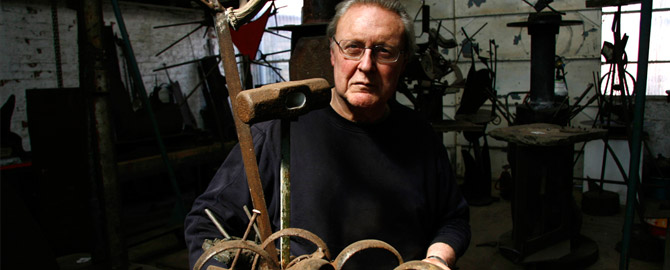
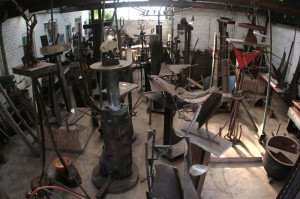
I was delighted to read this very informative record of the interview with Michael Lyons, which presented an excellent over-view of his ideas and his work. It reads very well indeed – perhaps it would be even more informative with additional images of Michael Lyons’ sculpture?